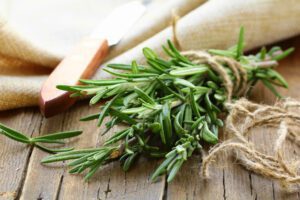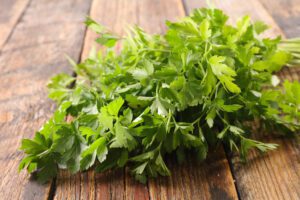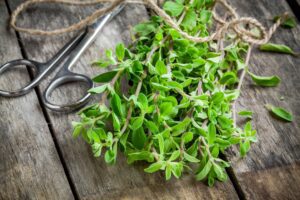Oh, Italian cuisine, you heart-stealer! It’s the culinary equivalent of that charming person who walks into a room, and suddenly, everyone’s in love.
From the zesty tang of lemon juice in a fresh tomato sauce to the rich, creamy embrace of a well-made pasta dish, Italian food is basically a hug for your taste buds.
And what’s the secret weapon behind all these lip-smacking dishes? You guessed it—those magical Italian herbs!
Let’s dive into our garden of delights, shall we?
Imagine basil and oregano as the Batman and Robin of the herb world, swooping in to save any pasta dish from blandness.
Then there’s rosemary, the wise old wizard who bestows an earthy charm on everything from a simple rice dish to a hearty vegetable soup.
Thyme and marjoram join the party, sprinkling their magic on seafood dishes and giving that tomato-based sauce an extra kick.
And let’s not forget the zesty punch of lemon zest in a classic Italian chicken parmesan or the briny flavor of capers in spaghetti carbonara.
For those who dare to tread the path less taken, chili peppers and black pepper throw in a fiery twist, igniting dishes with a heat as passionate as Italy.
But Italian cuisine isn’t just about following traditional recipes to the letter.
Oh, no. It’s about playing jazz with ingredients!
You have some leftover meat? Toss it in a pan with a few cherry tomatoes, bell peppers, fresh Italian herbs, and a splash of white wine, and baby, you’ve got a stew going.
Or, perhaps you’re feeling fancy and want to whip up a stuffed pasta with whatever’s in your fridge—go for it!
The beauty of Italian food lies in its versatility and ability to welcome many variations while still staying true to its roots.
Whether you’re a fan of classics like ragù alla bolognese and melanzane alla parmigiana or you’re all about exploring regional dishes from every Italian region, remember this: the essence of Italian-style cooking is all about savoring the moment, celebrating fresh ingredients, and, most importantly, sharing it with the people you love.
Now, if all this talk has got you dreaming of creamy sauces and tender eggplant, why not roll up your sleeves and bring a taste of Italy into your own kitchen? Every dish is a journey; trust me, you’ll want to savor every step.
Essential Italian Herbs
Gather ’round because we’re diving headfirst into the heartwarming, soul-stirring world of Italian cooking. It’s like an Italian nonna’s kitchen on a Sunday—full of laughter, stories, and a symphony of flavors that could make even the coldest heart sing.
We’re talking about basil that whispers sweet nothings of love, oregano that dances around in tomato sauce like it owns the place and rosemary that brings the essence of the Italian countryside straight to your plate.
Welcome to the ultimate guide to Italian style in your dishes, where every herb plays a starring role, and olive oil is the liquid gold that brings it all together.

Basil
First up, let’s talk basil— or ‘basilico,’ if you want to sound fancy at your next dinner party. This little green hero is the backbone of a killer pesto and the secret behind the freshest Margherita pizza you’ve ever tasted. But it’s not just about flavor; basil has a history of symbolizing love in some cultures.
Imagine that! A herb that’s all about freshness and more!

Oregano
Then there’s oregano, the life of the party in any Italian dish. This robust herb shines in those tomato-heavy masterpieces, from a simmering marinara sauce to the iconic pizza Napoletana. And when it’s dried? Oh, boy, it’s like oregano went to flavor boot camp and came back ready to kick some serious culinary butt.

Rosemary
Rosemary, or ‘rosmarino,’ is that friend who’s always reliable but never boring. It’s the MVP in dishes with roasted meats and gives your potatoes a certain je ne sais quoi.
Its pine-like fragrance is like a one-way ticket to the rolling hills of Italy, no passport required.

Thyme
Thyme, or ‘timo,’ might seem like it’s just tagging along, but trust me, it’s the quiet ones you’ve got to watch out for. This herb adds a subtle, earthy flavor, making it a perfect match for olive oil-infused creations.
It’s like the bass player in a rock band – not always in the spotlight, but the music wouldn’t be the same without it.

Sage
Sage, known as ‘salvia,’ is the wise old man of the herb world. A tad bitter, but in a good way, it brings a depth of flavor to dishes like saltimbocca and risotto that’s nothing short of magic. Plus, it’s packed with antioxidants, so you can feel all virtuous while chowing down.
It’s the herb that’s like a warm hug from Nonna with a splash of wisdom on top.

Parsley
Let’s not forget parsley – or ‘prezzemolo.’ This green wonder might get sidelined as a garnish, but it’s actually a flavor powerhouse. It’s the unsung hero of the soffritto, laying down a fresh, vibrant base for sauces and stews that’ll have you singing its praises.

Marjoram
Marjoram, or ‘maggiorana,’ might not be as well-known as its herb siblings, but it’s an essential ingredient in the Tuscan kitchen. Its slightly citrusy flavor adds a unique touch to seafood dishes and is a must-have for any hearty ribollita.

Bay Leaves
Lastly, let’s talk bay leaves—or ‘alloro’—the dark horse of Italian herbs. Sure, they might just look like a leaf, but add a couple to your pot of beans or meat sauce, and watch the magic unfold. It’s like an instant upgrade to any dish.
There you have it, folks – these essential Italian herbs that make every dish sing.

Growing Your Own Italian Herb Garden
Alright, my culinary adventurers and green-thumbed gurus, let’s embark on a journey to your backyard (or windowsill, no judgment) and create an Italian herb garden that’ll make even the most seasoned foodie nod in approval.
Why trek all the way to Italy when you can bring a slice of Italian style right to your home?
Picture this: You’re whipping up Italian dishes with herbs fresher than the Prince of Bel-Air, all while basking in the glory of your green-thumb achievements. Let’s dive into the “how-to,” shall we?
The best dishes start with the freshest ingredients, and there’s no more assurance of freshness than growing your own herbs. This section will guide you on the essentials of cultivating an Italian herb garden.
Choosing the Right Environment
Your Italian herbs will thrive in a sunny, well-draining environment. Whether you’ve got a sprawling garden or a modest balcony that catches some rays, there’s a primo spot for your little green buddies.
Now, remember, these herbs are like the cast of a reality TV show—they all have their preferences. Rosemary and thyme are the low-maintenance types craving that dry life, while basil is more high-maintenance, demanding a bit more TLC and moisture.
Planting and Care
When it comes to planting, think of it as setting up a blind date between your herbs and the soil – you want to make sure they hit it off.
Give them enough space to mingle and spread out. These herbs don’t like to be waterlogged, so let them thirst a bit between waterings. They say, “Hey, let me miss you a bit.” And don’t forget to give them a little haircut now and then (a.k.a. pruning) to keep them looking fresh and prevent any premature flowering – it’s all about maintaining that flavor, baby!
Pest Management
Ah, pests – the uninvited party crashers. But fear not! Arm yourself with nature’s bouncers: ladybugs to tackle aphids, garlic spray as the snail bouncer, and the good ol’ pick-and-toss method for those caterpillars.
Stay vigilant, my friends; the health of your Italian herb squad depends on it.
Enjoying Your Bounties
Imagine the endless possibilities with your homegrown herbs.
Drizzle some olive oil over a tomato sauce that sings with the magic of fresh basil, or whip up a creamy sauce for pasta dishes that’ll make your taste buds do the tarantella. Seafood dishes get a zesty kick with a splash of lemon juice, and let’s not forget the classic chicken parmesan, where a sprinkle of these herbs brings the dish to life. From the hearty vegetable soup of the Italian region to the sophisticated simplicity of a rice dish akin to French cuisine, your garden’s bounty will elevate your cooking to new heights.
The beauty of Italian cooking lies in its diversity, the simple joy of sharing meals made with love, and a hefty dose of your very own Italian herbs.

From Garden to Table: Using Italian Herbs in Cooking
Let’s march from the garden to the grand arena of your kitchen, where the real magic happens. We’re about to transform those lovingly nurtured Italian herbs into culinary masterpieces that’ll have everyone asking for seconds (or thirds, no judgment here).
Welcome to the crash course on using Italian herbs to elevate your cooking from “meh” to “Mamma Mia!” The magic doesn’t stop at harvesting – it extends to how these herbs are used to bring Italian flavor to life in your kitchen.
Harvesting and Storing
So, you’ve played the long game, and now it’s time to reap the rewards.
Harvesting is like catching your herbs in their prime time, right before they burst into flower. At this prime moment, their oils are so potent, you could swear they’re whispering Italian love songs. Early morning is the golden hour, folks.
Different herbs require different storage methods to retain their freshness and flavor. Basil, for example, should be kept at room temperature, while rosemary can be dried to extend its shelf life. Make sure to research the specific storage needs for each herb you plan to plant, and don’t be afraid to experiment with different methods to find what works best for you.
Cooking Tips and Tricks
Welcome to the heart of Italian cuisine, where olive oil reigns supreme, and tomato sauce is the canvas for your culinary art. Let’s explore how these green beauties can transform your dishes.
Remember, incorporating herbs into your cooking is an art that can take a lifetime to perfect.
- Start by simmering basil in a fresh tomato sauce. Trust us; it’s like a match made in Italian heaven.
- Mix rosemary, thyme, and garlic together for a flavorful marinade for meats or roasted vegetables.
- Don’t be shy with the bay leaves – add them to your soups and stews for an instant upgrade. Just remember to remove them before serving.
- Infuse olive oil with your herbs of choice for a drizzle of flavor on any dish.
- Add a sprinkle of dried oregano to your next batch of meatballs for a traditional Italian touch.
- Get creative and use fresh herbs in unexpected dishes, like mint leaves in a fruit salad or chives in scrambled eggs. The possibilities are endless!
- Experiment with different combinations and find what works best for your palate – that’s the beauty of cooking, after all.
Remember, a little goes a long way – you can always add more, but you can’t take it away. You’re the artist, and your palate is the canvas. Experiment, taste, and adjust!

Italian Cuisine and Fresh Herbs: A Match Made in Culinary Heaven
Italian food is all about simplicity, using fresh and quality ingredients to create flavorful dishes that bring people together. And when it comes to fresh ingredients, fresh herbs are the perfect complement to Italian food.
Herbs are the unsung heroes of Italian cooking, and understanding how to grow and use them is a gateway to a deeper appreciation of Italy’s culinary culture. Whether you visit Ferlito’s for a taste of our authentic dishes or cultivate your own Italian herb garden, the flavors of Italy are within your reach.
If you’re ready to explore the world of Italian herbs further, visit Ferlito’s Italian Restaurant in Grosse Pointe, MI. Our chefs have perfected the art of using fresh herbs in every dish.
